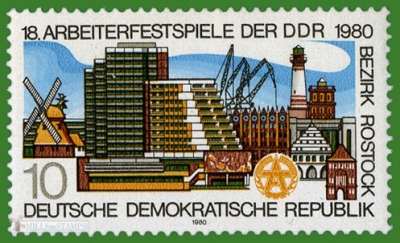-
18th Workers Festival in Rostock
DDR 1980.06.10
In issue: Stamp(s): 2
Issued in: sheets of 50 (5x10) stamps
-
Number by catalogue: Michel: 2514 Yvert: 2175 Scott: 2107
Perforation type: 14x14
Subject:
10 pfenings. Buildings-symbols of Rostock*
Additional:
*Rostock (from Polabian Roz toc, literally "to flow apart") is the largest city in the north German state Mecklenburg-Vorpommern. Rostock is located on the Warnow river; the quarter of Warnemünde 12 km north of the city centre lies directly on the coast of the Baltic Sea.
In the 11th century Polabian Slavs founded a settlement at the Warnow river called Roztoc (which means broadening of a river); the name Rostock is derived from that designation. The Danish king Valdemar I set the town aflame in 1161.
The rise of the city began with its membership in the Hanseatic League. In the 14th century it was a powerful seaport town with 12,000 inhabitants and the biggest city of Mecklenburg. Ships for cruising the Baltic Sea were constructed in Rostock. In 1419 the oldest university in Northern Europe, the University of Rostock, was founded.
At the end of the 15th century the dukes of Mecklenburg succeeded in enforcing their rule over the town of Rostock, which had until then been only nominally subjugate to their rule and essentially independent. They took advantage of a riot known as Domfehde, a failed uprising of the impoverished population. Subsequent quarrels with the dukes and persistent plundering led ultimately to a loss of economic and political power.
The strategic location of Rostock provoked the envy of its rivals. Danes and Swedes occupied the city twice, first during the Thirty Years' War (1618-48) and again from 1700 to 1721. Later, the French, under Napoleon, occupied the town for about a decade until 1813. It was here that Blücher, who was actually born in Rostock and who was one of few generals to fight on after the battle of Jena, surrendered to the French in 1806. This was only after furious street fighting in which he led some of the cavalry charges himself; the exhausted Prussians had, by the time of the surrender, neither food nor ammunition.
In the 20th century, important airplane manufacturing facilities were situated in the city, such as the Arado Flugzeugwerke in Warnemünde and the Heinkel Works with facilities at various places. It was at their facilities in Rostock-Marienehe where the world's pioneering jet plane made its test flights. Aeroplane construction ceased at the end of the Second World War.
Large parts of the central city were destroyed in World War II by Allied bombing in 1942 and 1945. Through reconstruction and subsequent extension, the city became a major industrial centre of the German Democratic Republic with the port being developed as the primary gate to the world.
Following the reunification of Germany in 1989/1990, Rostock lost its prior privileged position as the principal overseas port of the former GDR and became one of several German ports, now located in one of the least industrialised regions of reunited Germany. Despite large infrastructure investments, the city's economy declined in the 1990s but is now growing again.
Rostock's population dropped from nearly 260,000 in 1989 to about 200,000 today, primarily due to suburbanisation but also due to emigration to more prosperous western regions of Germany.
In Rostock's long history, the city carried three different coat of arms known as the Signum, Secretum and Sigillum. The Signum, which can be traced back to 1367, was developed last and is to this modern day the coat of arms of the city.
The flag depicts a golden griffin on blue background as well as the colours of the Hanseatic League, silver and red.
The coat of arms can not only be seen on flags, houses and bus stops, but also on bridges, gullies, fences, ships and restaurants.Topics: Windmills


